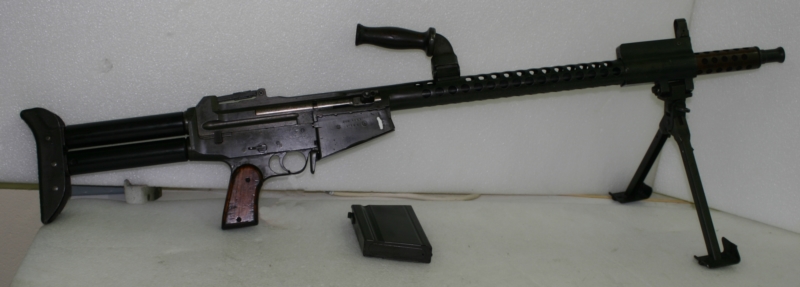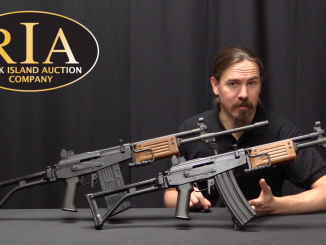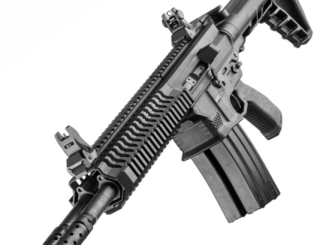
Since we first learned of its existence we have been very interested in the Israeli Dror light machine gun. To us, it has all the elements of a fascinating piece of firearms history – design elements from many different places, underground manufacture, use by a guerrilla army, and so on. The question we’ve always wondered about, though, is why there seems to be no record of the Dror ever being used in combat. Given Israeli resources at the time is was being developed (1948-1950), it must have been a very significant part of the armament program, and we would think that with all the work invested the guns would have been used extensively. Well, now we know why they weren’t.
Our friend Dean (who runs a forum on Saturday Night Specials) sent us some documents from the IDF archives relating to the Dror. They were (of course) in Hebrew, which we can read as well as we read Egyptian heiroglyphics. So we started asking around for folks who might be able to help with some translating, and discovered that Boris Karpa – whose blog Soviet Outpost we have enjoyed for a long time – is fluent in Hebrew and a professional translator. He made us a great deal for the amount of work required to go through our stack of reports, and I would not hesitate to recommend his services to anyone else looking for Russian or Hebrew translations.
So thanks to Dean and Boris, we now have three trials reports on the .303 and 8mm Dror light machine guns. The results, in a nutshell, are that the Dror was a terrible gun. We’re a bit saddened to hear the bad news about a gun we liked so much, but I’m sure the IDF/Haganah folks were a lot more dismayed at the time. The most extensive firing report is dated September 20, 1950 and was a side-by-side comparison of the 8mm (series B) Dror to the Bren and MG34. The tested were clearly biased towards the Dror, as they were brand new guns form the factory, while the Brens were heavily worn guns assembled from a bun of parts and the MG34s were used German guns. In addition, a representative form the factory was present and was allowed to tinker with the Drors as needed to fix problems. And yet the summary of the testing was still thus:
Dror Disadvantages
1. Disassembling the weapon is difficult and almost impossible to perform when prone.
2. The charging handle is part of the bolt, therefore: a. The handle is small and uncomfortable, injures the hand. b. Releasing the lock while cocking often injures the hand.
3. The magazine well faces downwards.
4. Inserting the magazine is difficult.
5. Bad feed (causes many malfunctions).
6. Overly forceful ejection tears the rim.
7. Torn rims fall into the magazine and causes stoppages in the functioning of the machine gun that cannot be overcome by soldiers in the field.
8. Barrel replacement is difficult.
9. The place where the barrel is held is not at the balance point.
10. Very sensitive to a lack of oil (does not function).
11. Very sensitive to dust (does not function).
12. Very sensitive to mud (does not function).
13. Very sensitive to water (does not function).
14. Very sensitive to sea water and sea shore sand (does not function). (In [items 12-14] there had been incidents where the moving parts stopped and could not be
moved, which made disassembly difficult)
15. Primer ignition is not certain (often stops).
16. Due to inaccuracy in manufacturing, magazines that fit one gun do not always fit the other one.
17. Selection is not accurate.
18. Great dispersion during automatic fire.
19. Releasing the trigger does not always cause gun to stop firing.Dror Advantages:
1. Light and comfortable to carry.
2. In semi-automatic fire it is more accurate than all the other firearms.
Ouch! We’re not really sure how the Dror became such a disaster – the Johnson LMG it was derived from had some issues, but nothing this catastrophic. There are a couple possible explanations, though. First, the initial blueprints and toolroom guns were brought in from the US and Canada and were dimensioned in inches. The Israelis had to convert to metric dimensions (I’m not entirely sure why, but they did it) and that process could easily louse up the critical tolerances. In addition, the toolroom guns appear to have been in the American .30-06 caliber, and the Israelis had to convert the plans and tooling first to .303 British and then to 8mm Mauser. Important tolerances and part interactions could be lost in those conversions, especially since they were done without the aid of the original designer back in the US. Another possibility is simply poor manufacturing – many of the factory workers building the Dror were new to firearms and to manufacturing in general, and the many-lugged rotating bolt and recoil operation of the Johnson-based design required some precise machining that may have been beyond the skills of the workers at the time.
If you are familiar with the Dror, you may be wondering at this point why thousands of them were made with a track record like this. Well, the folks in charge at the time jumped the gun a bit, and production was begun in mass well before the official trials had been run (whoops). If you think that’s a mistake, you’re not alone. To quote the final note from a 1949 early report on the gun’s performance:
I have been informed that, of this experimental series, over one thousand machine guns have been sent to production. I see the need to note that I see this as a most reckless step by the arms
production plants. We believe there is no place for entering the machine gun into mass production before all the problems are solved with the preconditions of its adoption.Major Izhak Brown,
In the name of the head of the instruction department
You can see the three main documents relating to Dror trials here:
Dror early conclusions (June 1949) – Synopsis of early testing of the 8mm Dror against the Bren and MG34
Dror firing report (undated, but between July 1949 and May 1950) – Opinion of changes necessary to the 8mm Dror, plus accuracy and 10,000-round endurance test of both 8mm and .303 Dror guns
Dror machine gun test report (September 1950) – Longer, detailed report on formal trials of 8mm Dror against Bren and MG34
For folks who can read Hebrew, you can download a copy of the original source documents,which include some material less related to the Dror that was not translated: IDF Archives Dror documents (pdfs in a zip archive). If you happen to have more information on the Dror, we would love to hear from you – we’re always looking for more information to fill in the story of this very interesting (to us, anyway) development program.




“Another possibility is simply poor manufacturing”
I’d bet that the majority of problems with the Dror stem for the above statement. The only issue I see is the Johnson 1941 rifle was designed with mass production in mind. In military jargon that translates as “unskilled labor force”. Why the Dror was not designed around the level or lack of industrialization in Israel at the time is beyond me.
Dean from Idaho.
PS
Thanks for the translations 😉
These guns were finally sold off and scrapped in the mid to late 1990s. They came into the US as part of another larger shipment of more marketable parts. The DRORs were sort of like the FN-D kits that are out there in bizarre calibers that no one wants to buy. Had they been saved, no one would’ve wanted them.
The dealer who brought them in ended up demolishing them, more or less, during the demil. Kits were in both .303 and 8mm, and buried in cosmoline. Some parts kits show up on gunbroker from time to time, but the great bulk went away with a cutting torch.
Any chance you know where someone might still find a .303 Dror kit? We have a couple in 8mm, and it would be great to have a .303 to go along…